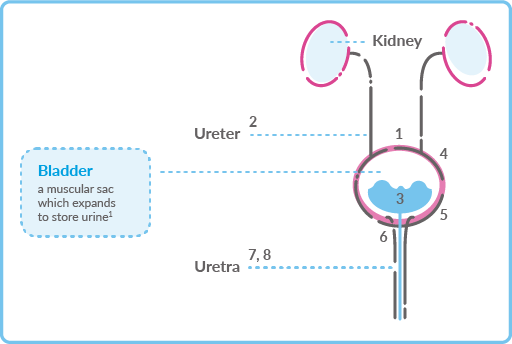
Bladder conditions
A healthy bladder
The bladder is a muscular sac that sits in the pelvis, just above and behind the pubic bone.

- When empty, the bladder is about the size of a pear but it expands as it fills with urine.
- After urine is made in the kidneys, it travels down two tubes called the ureters to the bladder.
- The bladder then stores the urine, allowing urination to be infrequent and voluntary.
- The bladder is lined by layers of muscle tissue that stretch to accommodate urine.
- During urination, the bladder muscles contract.
- Two sphincters (valves) open to allow urine to flow out.
- Urine exits the bladder via the urethra, which carries urine out of the body.
- The urethra is longer in men than women because it passes through the penis.
An unhealthy bladder
Many conditions can make your bladder unhealthy, so it can be challenging for doctors to make a diagnosis. Pain or hypersensitivity in the pelvic area, and the frequent and often urgent need to urinate can be due to a variety of possible problems, such as*:
- Cystitis – which is usually caused by a bacterial infection, but can also be drug induced (particularly by chemotherapy or illicit drugs) or occur when the bladder is irritated or inflamed for other reasons
- Overactive bladder – a feeling of urgency, with or without incontinence but usually accompanied by an increased frequency in urination
- Urinary incontinence – when loss of bladder control leads to involuntary urination
- Urinary retention – the accumulation of urine in the bladder that results from incomplete or inadequate bladder emptying
- Urinary stones – when stones (calculi) may form in the kidney and travel down to the bladder
- Haematuria – blood in the urine which can be microscopic or visible and may be a less serious problem like haemorrhoids, caused by an infection, or a more serious condition
- Bladder cancer – when malignant cells form in the tissue of the bladder and can spread into the muscle or the rest of the body
*Any symptoms you’re experiencing may not be as serious as you think, but it’s always advisable to get a professional opinion.
Cystitis (inflammation of the bladder) is one of the most common bladder conditions, with over 50% of women experiencing it at least once in their lifetime. It can have a range of possible causes or triggers, and exists in many forms; varying from a simple bacterial infection to more complex conditions, such as bladder pain syndrome/interstitial cystitis (BPS/IC) which, as yet, lacks a detectible cause. This can make cystitis quite a challenging condition to diagnose and therefore treat. However, a better understanding of bladder conditions can help make the route to treatment a bit smoother.

